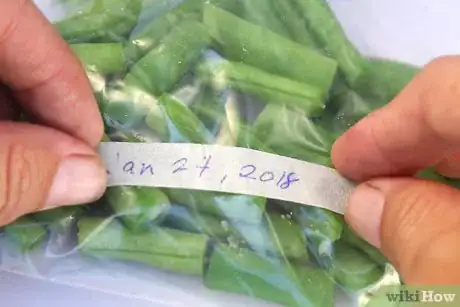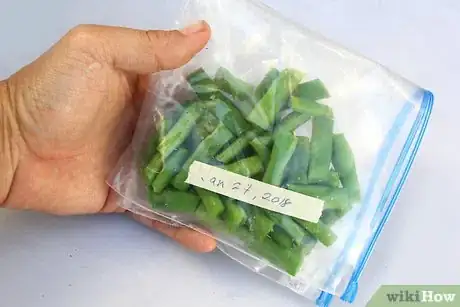This article was co-authored by wikiHow Staff. Our trained team of editors and researchers validate articles for accuracy and comprehensiveness. wikiHow's Content Management Team carefully monitors the work from our editorial staff to ensure that each article is backed by trusted research and meets our high quality standards.
There are 8 references cited in this article, which can be found at the bottom of the page.
This article has been viewed 49,241 times.
Learn more...
Often confused for a type of green bean, runner beans are actually a completely different plant, which means they have their own unique ways of being prepared, cooked, and stored. Like green beans, however, the best way to freeze your unused portion is by blanching them to lock in moisture. Start by washing the beans in cold water and removing the fibrous stems and strings from each pod. Boil the beans for 3 minutes, then dry them by hand and separate them into airtight freezer bags. When stored properly, they should keep for up to a year.
Steps
Washing and Trimming the Beans
-
1Rinse the beans under a stream of cool water. Place the fresh runner beans in a colander or wire strainer and run them under the faucet to wash away dirt and loose debris. Shake the colander or toss the beans by hand periodically to ensure that the water reaches every part. When you’re finished, allow the excess water to drain out of the colander completely.[1]
- A thorough rinse is also useful for doing away with traces of insects, fertilizer, or chemicals, which are often found on freshly-picked veggies.
-
2Trim the ends off of the beans. Gather up a handful of beans and line them up end-to-end on your cutting board. Then, using a sharp kitchen knife, slice off the fibrous stem ends and discard them. Repeat the trimming process for all of the beans you plan on freezing.[2]
- Only remove about 1⁄2 inch (1.3 cm) from each end so there’s still plenty of edible bean left.
Advertisement -
3De-string the bean pods. Like many other varieties of shell beans, the pods of runner beans are held together by a tough string running down the middle. You can remove this string by grabbing it from one end and pulling it away it one easy motion. Make sure you strip the entire string, or you could end up chewing on it later.[3]
- The pod strings will usually start coming away on their own when you trim the stems. If not, you may have to get them started with your fingernail.
- Try not to miss any strings. Getting them stuck in your teeth isn’t a pleasant experience.
-
4Cut the runner beans into 1–2 inches (2.5–5.1 cm) pieces. If you tend to slice or break your beans into smaller segments, doing it before you put them into storage will save you valuable time later on. Use clean, precise cuts to reduce the beans to a uniform size. Many chefs prefer square or diamond-shaped pieces for beans with broad, flat pods like runners.
- Avoid cutting them too small, or they’ll be more likely to stick together when frozen.
- Once you’ve precut your runner beans, you’ll be able to simply take them out of storage, dump them into a pot of water, and cook them to a tender, flavorful finish without the hassle of having to prepare them.
Blanching the Beans
-
1Bring a pot of water to a low boil. Heat the water until it just begins to bubble, then adjust the temperature to keep it constant. You want the blanching water to be hot enough to hydrate and soften the runners, but not so hot that it cooks them too quickly.
- Make sure the pot you’re using is big enough to hold all of the beans you want to freeze. If you're preparing a particularly large crop of fresh beans, you may need to blanch them in separate batches.
- Adding a pinch of salt to the blanching water may also help preserve the runner beans longer.[4]
-
2Boil the runner beans for 3 minutes. Drop the beans into the pot a handful at a time and give them a stir. Set a timer for 3 minutes and leave the pot uncovered. At the end of this time, the beans should appear plump and bright green.[5]
- As the beans boil, they’ll take in moisture, which will allow them to freeze easily.
- Keep an eye on the color and texture of the runners as you’re blanching them. If they look exceptionally dark or soft, they may be in danger of overcooking.
-
3Cool the beans in cold water for 1-3 minutes. Turn off the cooktop and drain the boiling water from the pot. Plunge the runner beans into a separate bowl filled with equal parts water and ice to neutralize the heat of the boiling water. Alternatively, you can transfer them back to the colander and run them directly under the faucet.
- Placing the beans in cold water immediately after blanching them will halt the heating process and prevent them from actually cooking through. It will also lower their temperature gradually in preparation for freezing.[6]
-
4Pat the beans dry. Remove the beans from the ice bath or colander and pour them out onto a layer of folded paper towels. Dab them lightly by hand to soak up as much of the remaining moisture as you can. Afterwards, let them finish air drying for 5-10 minutes.[7]
- The drier the beans are when they go into the freezer, the less likely they are to form ice crystals.[8]
- Be careful not to mash or break the beans while you’re drying them. They might be a little soft from blanching.
Packing and Storing the Beans
-
1Freeze the beans on a baking sheet before you bag them (optional). Small pieces of food are prone to clumping when they’re all thrown into the same container together. One way around this is to spread out and chill the runners on another surface first. Afterwards, you can funnel them into a freezer bag and put them away without having to worry about them coming out in one big chunk.[9]
- Wait until the beans harden to the touch before consolidating them into a single container. This will typically take 20-30 minutes, though you can leave them in the freezer until they're fully frozen, if you prefer.
-
2Place the blanched beans into plastic freezer bags. Once the beans have had ample time to dry, they can go directly into their storage container. Fill each bag roughly ¾ of the way full, leaving about 1 inch (2.5 cm) of headspace at the top. Press the bags from both sides to gently squeeze out the excess air, then seal them up.[10]
- Check your freezer bags for holes, splits, broken seals, and other signs of damage before closing them up.
- If you’re short on storage bags, a large, resealable plastic container with a locking lid will also do the trick.
- For more convenient preparation, consider dividing up the beans into precise portions and bundling them in plastic wrap within each individual bag or container.[11]
-
3Label the bags with the contents and date. Write the name of the item and the current month somewhere in plain sight on each bag. That way, you’ll be able to keep track of how long they’ve been in storage. Keep the labels facing the front of the freezer so you can check them at a glance.[12]
- There’s no need to get too specific with the date, since runner beans and similar veggies will last many months in the freezer.
-
4Store the beans for up to a year. They’ll have the best flavor and texture if used within 3-4 months. However, their high water content coupled with their frigid surroundings means they’ll never really go bad, so you’re free to keep them put away until you need them. Be sure to use up the beans in the order that you put them into storage.[13]
- When cooked, frozen runner beans should retain most of their original flavor and texture.
-
5Watch out for freezer burn. Dispose of the frozen runners if they begin to wrinkle or take on a dull color, or if large chunks of ice have begun forming on them inside the bag. Similarly, you'll want to play it safe and throw out bags that show signs of damage after being placed in the freezer. When exposed directly to the cold for too long, the taste and texture of the beans will effectively be ruined.[14]
- Blanched runner beans are more likely to freezer burn if you don't dry them off thoroughly before packing them up.
- It’s a good idea to replace runner beans that have been frozen for longer than a year with a new batch, even if they still look edible. After enough time, bacteria can begin slowly creeping in, making them unsafe to eat.[15]
Things You'll Need
- Gallon-sized plastic freezer bag or resealable plastic container
- Colander or wire strainer
- Large cooking pot
- Large bowl
- Sharp kitchen knife
- Cutting board
- Baking sheet (optional)
- Paper towels
References
- ↑ http://www.cookuk.co.uk/techniques/FreezeVegetables.htm
- ↑ http://www.bhg.com/recipes/how-to/preserving-canning/freeze-green-beans/
- ↑ https://www.bbcgoodfood.com/glossary/runner-bean
- ↑ http://www.seriouseats.com/2014/06/are-the-rules-of-big-pot-blanching-true.html
- ↑ https://dancinggecko.wordpress.com/2008/09/28/how-to-freeze-runner-beans/
- ↑ http://www.seriouseats.com/2014/06/are-the-rules-of-big-pot-blanching-true.html
- ↑ http://www.cookuk.co.uk/techniques/FreezeVegetables.htm
- ↑ https://anoregoncottage.com/the-easy-way-to-freeze-green-beans-no-blanching/
- ↑ https://www.bbcgoodfood.com/howto/guide/top-tips-freezing-food
- ↑ http://www.bhg.com/recipes/how-to/preserving-canning/freeze-green-beans/
- ↑ http://www.cookuk.co.uk/techniques/FreezeVegetables.htm
- ↑ http://www.bhg.com/recipes/how-to/preserving-canning/freeze-green-beans/
- ↑ http://www.bhg.com/recipes/how-to/preserving-canning/freeze-green-beans/
- ↑ http://dontwastethecrumbs.com/2012/10/freezer-burn-gross-yet-safe-and-10-tips-for-prevention/
- ↑ https://www.bbcgoodfood.com/howto/guide/top-tips-freezing-food
About This Article
To freeze runner beans, trim the ends off, then de-string each bean by grabbing the small seam on one end and pulling it to the other end. Cut the beans into 1 to 2 inch pieces, then boil them for 3 minutes in a pot of water. After 3 minutes, plunge the beans into an ice bath and let them sit for 1-3 minutes. Then, pat the beans dry and pack them into freezer bags, leaving 1 inch of headspace at the top. Put the bags in your freezer and your beans will keep for 1 year! For more tips, including how to wash the beans before trimming them, read on!






























































